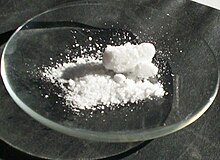
Back Kaliumjodied Afrikaans يوديد البوتاسيوم Arabic Kalium yodid Azerbaijani Ёдыд калю BE-X-OLD Калиев йодид Bulgarian পটাসিয়াম আয়োডাইড Bengali/Bangla Kalij-jodid BS Iodur de potassi Catalan Jodid draselný Czech Kaliumiodid Danish
 | |
 | |
| Clinical data | |
|---|---|
| Trade names | Iosat, Thyrosafe, Thyroshield, others |
| Other names | SSKI |
| AHFS/Drugs.com | Monograph |
| License data | |
| Routes of administration | By mouth |
| ATC code | |
| Legal status | |
| Legal status | |
| Identifiers | |
| |
| CAS Number | |
| PubChem CID | |
| DrugBank | |
| ChemSpider | |
| UNII | |
| KEGG | |
| ChEBI | |
| ChEMBL | |
| CompTox Dashboard (EPA) | |
| ECHA InfoCard | 100.028.782 |
| Chemical and physical data | |
| Formula | KI |
| 3D model (JSmol) | |
| Density | 3.13[2] g/cm3 |
| Melting point | 681 °C (1,258 °F) |
| Boiling point | 1,330 °C (2,430 °F) |
| Solubility in water | 1280 mg/mL (0 °C (32 °F)) 1400 mg/mL (20 °C (68 °F)) 1760 mg/mL (60 °C (140 °F)) 2060 mg/mL (100 °C (212 °F)) |
| |
| |
Potassium iodide is a chemical compound, medication, and dietary supplement.[4][5] It is a medication used for treating hyperthyroidism, in radiation emergencies, and for protecting the thyroid gland when certain types of radiopharmaceuticals are used.[6] In the third world it is also used for treating skin sporotrichosis and phycomycosis.[6][7] It is a supplement used by people with low dietary intake of iodine.[5] It is administered orally.[6]
Common side effects include vomiting, diarrhea, abdominal pain, rash, and swelling of the salivary glands.[6] Other side effects include allergic reactions, headache, goitre, and depression.[7] While use during pregnancy may harm the baby, its use is still recommended in radiation emergencies.[6] Potassium iodide has the chemical formula KI.[8] Commercially it is made by mixing potassium hydroxide with iodine.[9][10]
Potassium iodide has been used medically since at least 1820.[11] It is on the World Health Organization's List of Essential Medicines.[12] Potassium iodide is available as a generic medication and over the counter.[13] Potassium iodide is also used for the iodization of salt.[5]
- ^ "FDA-sourced list of all drugs with black box warnings (Use Download Full Results and View Query links.)". nctr-crs.fda.gov. FDA. Retrieved 22 October 2023.
- ^ "Density of Potassium iodide". Aqua-Calc. Archived from the original on 21 April 2021. Retrieved 21 April 2021.
- ^ "Potassium Iodide" (PDF). Archived (PDF) from the original on 10 May 2019. Retrieved 10 May 2019.
- ^ National Research Council, Division on Earth and Life Studies, Board on Radiation Effects Research, Committee to Assess the Distribution and Administration of Potassium Iodide in the Event of a Nuclear Incident (2004). Distribution and Administration of Potassium Iodide in the Event of a Nuclear Incident. National Academies Press. p. 10. ISBN 978-0-309-09098-8. Archived from the original on 18 September 2017.
- ^ a b c Stwertka A (2002). A Guide to the Elements. Oxford University Press, USA. p. 137. ISBN 978-0-19-515026-1. Archived from the original on 14 September 2017.
- ^ a b c d e "Potassium Iodide". The American Society of Health-System Pharmacists. Archived from the original on 16 January 2017. Retrieved 8 January 2017.
- ^ a b World Health Organization (2009). Stuart MC, Kouimtzi M, Hill SR (eds.). WHO Model Formulary 2008. World Health Organization. p. 390. hdl:10665/44053. ISBN 978-92-4-154765-9.
- ^ Ensminger ME, Ensminger AH (1993). Foods & Nutrition Encyclopedia, Two Volume Set (s ed.). CRC Press. p. 16. ISBN 978-0-8493-8980-1. Archived from the original on 13 August 2017.
- ^ Kaiho T (2014). Iodine Chemistry and Applications. John Wiley & Sons. p. 57. ISBN 978-1-118-87865-1. Archived from the original on 13 August 2017.
- ^ Center for Drug Evaluation and Research (December 2001). "Potassium Iodide as a Thyroid Blocking Agent in Radiation Emergencies". U.S. Food and Drug Administration. Archived from the original on 19 August 2020. Retrieved 22 August 2020.
- ^ Oriel JD (2012). The Scars of Venus: A History of Venereology. Springer Science & Business Media. p. 87. ISBN 978-1-4471-2068-1. Archived from the original on 14 September 2017.
- ^ World Health Organization (2019). World Health Organization model list of essential medicines: 21st list 2019. Geneva: World Health Organization. hdl:10665/325771. WHO/MVP/EMP/IAU/2019.06. License: CC BY-NC-SA 3.0 IGO.
- ^ Hamilton R (2015). Tarascon Pocket Pharmacopoeia 2015 Deluxe Lab-Coat Edition. Jones & Bartlett Learning. p. 224. ISBN 978-1-284-05756-0.
© MMXXIII Rich X Search. We shall prevail. All rights reserved. Rich X Search
